Reading Time: 13 min
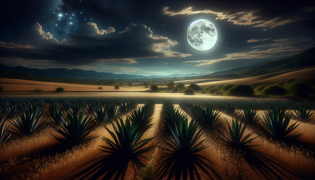
About Story: El Chupacabra is a Legend from mexico set in the Contemporary. This Descriptive tale explores themes of Good vs. Evil and is suitable for Adults. It offers Cultural insights. A young shepherd's quest to unveil the truth behind a legendary creature threatens to unravel his peaceful village. .
In the quiet stretches of rural Mexico, where the moonlight casts long silver beams across the open fields, stories of the unknown often begin around the gentle glow of a humble fire. There, farmers and their families gather under star‑filled skies, sharing laughter, passing around homemade tortillas, and whispering tales that mix apprehension with wonder. These tales travel across generations like migrating birds, always returning home with new details and renewed mystery. Among the many legends that wander through the region, one stands out—a creature that slips through the darkness, leaving only puzzled whispers in its wake.
The village of San Martín rests between rolling hills and dense forests, its patchwork of cornfields and agave plants stretching out in every direction. The locals here rise at dawn to tend their land, working side by side with the same soil that has supported them for centuries. Wooden fences, worn smooth by time, outline family farms that have stood strong through harsh summers and torrential rains. In San Martín, tradition isn’t just preserved—it thrives, breathing through every conversation and color in the marketplace. Yet, behind the warmth and closeness, a quiet apprehension pulses like a distant drumbeat. Livestock have been vanishing, or worse, discovered drained of blood in a manner no one can easily explain. The name whispered on everyone’s lips is one no one dares to say too loudly: El Chupacabra.
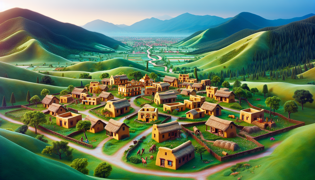
Mateo, a young shepherd who had grown up with dust on his boots and the bleating of sheep as his lullaby, found himself at the center of these dark rumors. His father and grandfather before him had prided themselves on keeping their herds healthy, believing their care to be a sacred duty. But recently, a grim pattern had emerged—cattle found lifeless, their bodies eerily intact save for the chilling discovery that they had been completely drained of blood. Some of Mateo’s neighbors clung to the idea that this was the work of coyotes or a rogue pack of wolves. Others, particularly the village elders who had seen strange things in their youth, began to speak of ancient guardians and punishments for disrespecting nature. Mateo, torn between the reality of his family’s losses and the tantalizing legends swirling around him, decided that action was the only way forward.
Armed with a sturdy lantern, a few well-sharpened tools, and the determination born of desperation, Mateo set out into the moonlit fields. Nights in San Martín were often filled with the gentle hum of crickets and the sway of tall grasses under the breath of a light wind. On these nights, however, a tense silence seemed to fill the air, as though the land itself was holding its breath. Hours slipped by, and nothing stirred except for an owl gliding overhead and the rustling of distant bushes. Sleep tugged at Mateo’s eyelids, but his resolve kept him awake. It wasn’t until the sky began to lighten at the edges—a prelude to dawn—that he encountered something that made his heart pound.
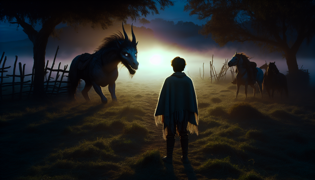
Standing at the far edge of the field, framed by the first rays of the sun, was a figure unlike anything he had seen before. It was tall but stooped, with skin that bore a rough texture like sun‑baked clay. Its eyes emitted a faint, unsettling glow, catching even the slightest sliver of light. Sharp fangs protruded from its mouth, glimmering with the threat of violence. When it growled, the sound cut through the morning stillness like a knife through silk. Fear rooted Mateo to the ground, his mind spinning between disbelief and terror. In a moment that felt stretched thin by adrenaline, the creature locked eyes with him, seeming to size him up. Then, as quickly as it had appeared, it slipped away into the folds of the early morning mist, disappearing beyond the farm’s boundary.
Word of Mateo’s encounter spread through San Martín before midday. People gathered around the central well, letting their chores wait, eager to hear every detail of the young shepherd’s tale. While some dismissed it as a trick of the light or the result of exhaustion, many recognized the sincerity in Mateo’s trembling voice and the way his hands shook as he described the creature’s glowing eyes. The older villagers exchanged glances, recalling stories from their youth—stories that had never been fully believed, yet stubbornly refused to die. As dusk approached, a tangible shift in the village’s atmosphere took hold. The once-lively chatter of neighbors exchanging recipes and gossip turned into hushed tones, with people casting nervous glances at the horizon.
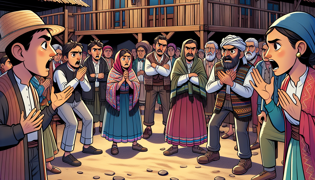
Mateo, emboldened by both fear and a sense of responsibility, organized night patrols. Families who had lost livestock the previous week eagerly volunteered, and even those who were skeptical thought it best to keep watch. They divided the fields into sections, each group carrying lanterns and protective amulets that the village elders claimed could ward off evil. During these patrols, friendships strengthened: neighbors shared stories of their ancestors, talked about the best ways to fertilize corn, and even swapped jokes about ghosts and goblins to ease the tension. Yet each dawn brought the same disheartening truth—no new clues, no undeniable evidence of the creature’s whereabouts. Livestock continued to vanish under the silver glow of the moon.
It was around this time that the anxiety gripping the village started to affect daily life. Some residents hesitated to let their children roam freely, fearing the creature might soon tire of livestock. Others blamed each other for not caring for the land properly, claiming that a guardian spirit was punishing them for straying from old rituals meant to honor the fields. Conflict simmered on the edges of every conversation. Mateo, though exhausted by nights of vigilant watch, refused to abandon his quest for answers. Something about his brief, chilling confrontation with the creature had kindled in him an urge to understand it—was it a demon lurking in the shadows, or was it an embodiment of something more primal and ancient?
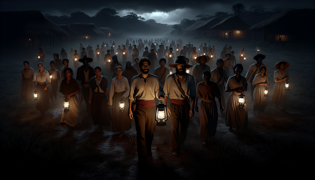
Digging through the few old manuscripts the village had preserved, Mateo found fragments of myths passed down through word of mouth and scratched into faded notebooks. These texts spoke of guardians awakened by imbalance—beings that emerged when humanity took too much and offered too little back to the earth. Each paragraph read like a puzzle, referencing the cyclical nature of life, the importance of respect and harmony, and the dire consequences of neglecting those values. As he poured over these legends by candlelight, the memory of the creature’s glowing eyes flickered in his thoughts. He felt a strange combination of fear and empathy, as though the beast was less a random predator and more a misunderstood force of the land itself.
In the weeks that followed, rumors began to circulate that perhaps the solution wasn’t in trapping or killing the creature but in addressing whatever had driven it to such terrifying displays. Some scoffed at the idea, insisting that a blood‑sucking fiend needed to be eradicated, not appeased. Others, including the elders, saw glimmers of hope in Mateo’s discoveries, recalling a time when ceremonies were performed to honor the changing seasons and ensure the land’s continued generosity. Skepticism clashed with belief, creating tension within families and friendships. Yet, the more debates raged on, the clearer it became that the village needed a united approach if they were ever to bring peace back to their fields.
The night patrols continued, albeit with dwindling numbers as fatigue and fear took their toll. Mateo felt the pressure mounting. Every time he crossed the threshold of his family’s farm, he could see the worry etched into his mother’s face and the exhaustion behind his father’s eyes. He spent many late evenings making rounds by himself, leaving a lantern in one hand and carrying a borrowed rifle in the other—just in case. Despite the close calls and unexplained noises in the dark, he never managed to confront the creature again. It was as though it sensed his presence and remained just out of reach, leaving footprints in the mud or broken stalks of corn as silent tokens of its existence.
Emotions in San Martín reached a fever pitch one night when a prized bull—belonging to a farmer who had stubbornly denied the possibility of any supernatural force—was found dead, drained like the rest. The farmer, furious and grief-stricken, accused the villagers of ignorance, claiming they had all lost their sense. He stormed through the streets, his anger fueled by the flickering lanterns, promising that he would deal with the creature on his own if no one else had the courage. His outburst ignited a spark that revealed just how deeply fear had wormed its way into the hearts of the community. Neighbors began to argue openly, some demanding an all-out hunt to destroy the beast, while others pleaded for caution, worried that rash actions might only provoke whatever lurked in the fields.

Sensing the urgency, Mateo asked for a meeting with the village elders and the most respected farmers. They gathered in a modest adobe building that had served as the community hall for decades, its walls lined with colorful murals depicting harvests and traditional celebrations. Through the thick tension, Mateo presented the fragments of stories he had found, laying out a theory that the creature might be a warning—an ancient guardian lashing out because the land was being overused and underappreciated. He spoke with conviction, his words quavering only slightly as he described a path of balance and coexistence. Yes, it sounded fantastical, but he reminded them that San Martín owed its lifeblood to the earth and, by extension, to every living thing that resided on it.
At first, his words were met with stunned silence. Then, an elder known for her knowledge of herbal remedies and spiritual traditions broke the quiet, recalling rituals from her childhood. She remembered watching her grandmother offer cornmeal and water to the fields, whispering prayers of gratitude. Another elder chimed in, speaking of old ceremonies once performed near a sacred spring hidden in the hills. These memories, long buried, emerged like seeds sprouting after the first rains. Discussion flowed well into the night, and when dawn broke, the village had reached a fragile consensus: they would attempt to restore harmony with nature, hoping to quell the anger of the creature they believed to be El Chupacabra.
No one expected changes overnight, but the shift in attitude was palpable. Families became more mindful of the resources they used, trying to minimize waste and show respect to the land. Some returned to older methods of farming that demanded more manual labor but less intervention with chemicals. Others sought to replant trees that had been cut down over the years, aiming to revive the natural balance of the region. Village children learned the names of local bird species and insects, understanding that each creature played a role in the tapestry of life. Ceremonies were revived, too—small gatherings where offerings of fruit and blessed water were left in special parts of the fields.
Little by little, the nights calmed. Livestock began to wander peacefully under the moonlight without disappearing. The anxious hush that had once engulfed the village lifted, replaced by the comforting chorus of crickets and frogs. Though no one claimed to have seen the creature again, its presence still lingered in the collective memory of San Martín. For Mateo, the silence of the nights now felt less like a dreadful hush and more like a peaceful lullaby—an affirmation that perhaps the village was finally on the right path.
One brisk evening, a group of farmers gathered in the central plaza to share tamales and sweet hibiscus tea after a long day in the fields. They talked about how things had changed: the once-feared legend of El Chupacabra was now openly discussed, not as a monstrous fiend but as a complex symbol of nature’s delicate balance. Their conversation meandered from harvest predictions to local gossip, yet every so often, the topic drifted back to the creature. Some said it was out there still, watching over them in the thick darkness of the forest or perched silently in the canopy of ancient trees. Others believed it had returned to a deeper realm, content that its message had been heard. Mateo sat among them, quiet but content, knowing he had played a part in guiding San Martín toward a new understanding.
Time moved on. Seasons came and went, each one now acknowledged with a small act of gratitude. During the harvest festival, children paraded through the streets with handmade masks representing animals of the region—foxes, owls, even silhouettes of a strange, tall creature with gleaming eyes. Laughter and music filled the air, reflecting a renewed bond that had been forged between the village and the land sustaining it. The more the community respected nature, the more nature seemed to reciprocate. The fields yielded healthier crops, and the livestock flourished. A sense of peace, which had once seemed like a distant memory, wrapped itself around San Martín like a well-worn blanket.
El Chupacabra’s legend evolved alongside the people who once feared it. Where it had once conjured images of fangs and terror, it now stood as a living reminder—albeit unseen—of the cost of neglecting the very ground beneath one’s feet. The older generation, with fresh reason to pass on their tales, told the stories anew: of a shepherd named Mateo whose courage transcended his fear, of a village that chose unity over division, and of a creature both ferocious and wise, revealing that sometimes what we dread is merely an echo of the balance we’ve lost.
Years later, as twilight painted the horizon in purple and gold, Mateo would often walk the boundary of his family’s fields, lantern in hand, remembering that fateful night. He would pause at the very spot where he had first locked eyes with the creature, replaying the encounter in his mind. Instead of shuddering with fear, he felt an odd sense of reverence, as though part of him had awakened to life’s deeper mysteries in that single moment. He carried that awareness with him always—a quiet, persistent knowledge that we share this land, and what we give of ourselves to it is what we will ultimately receive in return.
And so, in San Martín, when a full moon illuminates the fields in a ghostly glow and the hush of midnight settles over the village, people sometimes cast their eyes to the edges of the forest. They remember the nights of dread and the mornings of uncertainty, but they also recall the courage, curiosity, and compassion that helped them confront the unknown. In those silent moments, if you listen closely, you might hear the faintest growl—or perhaps just the wind threading through the tall grass. Either way, there’s an understanding that the creature, El Chupacabra, remains a guardian of the old ways, a spectral presence bound to the land. And in that unspoken bond lies the true power of San Martín’s story: a reminder that respect for nature and for each other forms the strongest protection against the shadows that lurk just beyond the light of our lanterns.

















